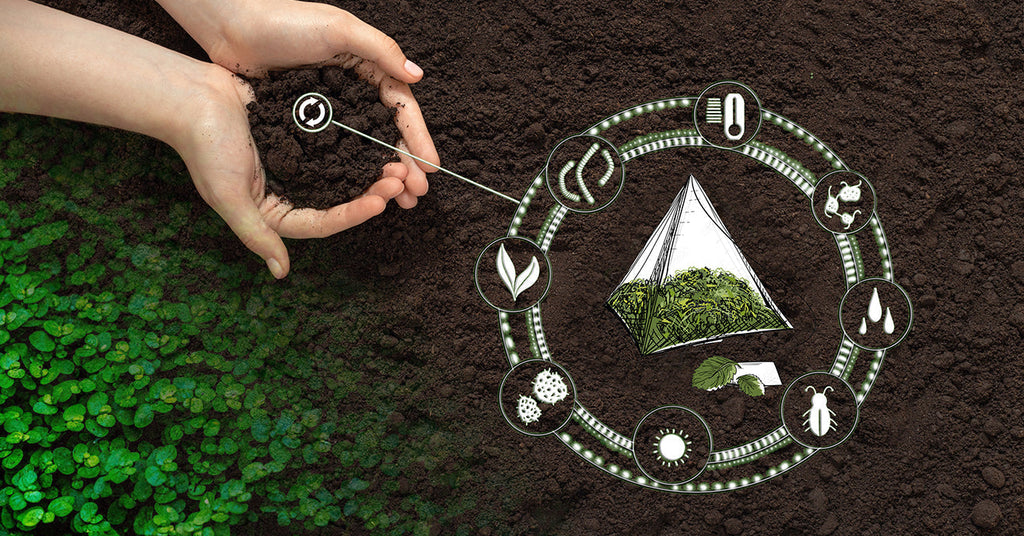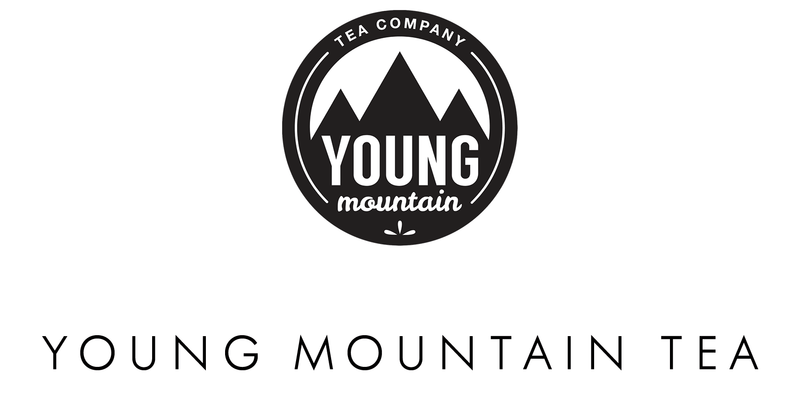Zero Waste 101

Ahh, the tea bag conundrum! Their convenience is as undeniable as their waste. In our journey to develop tea bags that align with our environmental values, we learned that sustainable packaging is battle ground zero (waste) for greenwashing. So over the last six months, we combed through reports, spoke with sustainable packaging experts, and waded deep into the waste debate to make sure our new tea bags, which will be available later this year, truly reflect sound science. Here’s what we learned…
What Is The Difference Between Biodegradable VS Compostable?
Think of biodegradability as a spectrum defined by how long it takes for something to return to natural elements. On one end of the spectrum is the least legit side of sustainability: microplastics. Microorganisms might break the packaging down into millions of small parts, but those tiny plastic particles might not go away, and they don’t support the growth of other living things.
On the opposite side of the biodegradable spectrum, we have backyard compostable. The packaging can be quickly and easily broken down into organic materials that can be added to soils and contribute positively to nutrient availability.
Here’s an easy way to think about it: everything that is compostable is biodegradable, but not everything that is biodegradable is compostable. To feel good about the biodegradability of the material at hand, you have to know the material type. That’s why for the launch of our tea bags, we’re going with tea bags that are made from 100% sugar cane.
What Is The Difference Between Backyard Compostable VS Commercial Compostable?
The primary difference between backyard composting and commercial composting (aka industrial aka municipal) is scale. According to Braeden Cohen, an LA-based organic waste specialist, “Commercial compost facilities are thousands to millions of times larger than backyard systems. It is the size of the pile that enables it to reach the high temps and create the proper environment necessary to break down the materials.”
For your average backyard compost, which gets primarily food waste a few times a week and is subject to local weather conditions, it’s difficult for the pile to get hot enough to break down the compounds in a short window. So if you throw a commercial compostable material into your backyard compost, it will eventually break down, but perhaps not in a timeline that’s ideal for fertilizing your tomatoes. A pro tip is to cut up the material to smaller sizes before throwing it into your backyard compost.
Beyond that, there are the incentives involved. One packaging manufacturer explained to us that for a commercial facility, compost is the product. So those commercial facilities have a vested interest in ensuring that all of the inputs break down, do so quickly, and meet nutrient standards for quality. They do this by closely monitoring and adjusting environmental conditions including humidity, oxygen, and the ratio of brown to green materials (ideally 3:1). Of course, the challenge here is that many parts of the country lack any commercial composting. One of the ways that changes is when informed citizens like you decide to get involved in pushing local governments to innovate.
How Does Food Safety Impact Sustainable Packaging Options
An extra layer of complexity is that while we want our packaging to break down, we also want it to be a good storage container for tea. If packaging degrades too quickly, and it can’t provide its primary function of protecting the tea, we actually risk a significant amount of product loss and ADDING to the waste problems we have in our country. So part of the challenge is that we want materials that will break down quickly, but not too quickly.
Connected to this is quality. In our search to find teas that will delight your cup, we look for high-quality teas with complex flavors. When teas degrade due to improper storage, you lose many of the nuances of flavor that tea makers have worked so hard to create. So without proper packaging, we’d be doing a disservice to both you and the tea maker!
Is Biodegradable Packaging Sustainable?

We expected the answer to this to be a clear “yes!” But as we dug into it all, we realized it’s tough to conclusively say whether or not zero waste packaging is sustainable. As stated in a recent report from the State of Oregon’s Department of Environmental Quality (DEQ), "Many compostable packages are made of bio-based materials and inherit the significant environmental burdens from their production. These burdens are often much greater than the offset benefits that composting provides.”
For example, the carbon footprint of using virgin raw materials to make backyard compostable packaging can be significantly higher than using post-consumer recycled (PCR) materials that already exist and end up in the landfill.
So if you’re after sustainability, it really matters what sustainable means to you. Briana Buckles, the Sustainability Manager for Yogi Teas, said it’s best to choose a few specific metrics and use those to determine overall sustainability. Because the truth is, the whole scenario is too complex to distill down to a simple “yes” or “no.”
Towards Zero Waste
Waste management is a deep issue that will take the collective action of all stakeholders to address. And everyone has a role, from the manufacturers developing better materials, to the researchers understanding the wider context of sustainability, to companies like ours digging into the complexities of sustainable packaging, to tea drinkers like you caring enough to understand the nuances involved. Zero waste is an ideal, and we’re moving towards it, but the only way we’ll move towards it is together.
Want To Explore Other Similar Topics?
Blog Author:

Raj Vable, Founder
He has been confounded by the leaf since his first transcendental encounter with white tea in 2010. Three years later, he started Young Mountain Tea to bridge his budding tea obsession with his interest in traveling in the mountains and previous experience creating job opportunities in rural India. He revels in working across cultures and can be regularly found trying to get the rest of the team on board with another outlandish tea project. His favorite teas remain white, and he’s always searching for the next cup of magic.





Comments on this post (1)
Thank you for your responsible caring presence in this world.
— Nancy-Laurel Pettersen